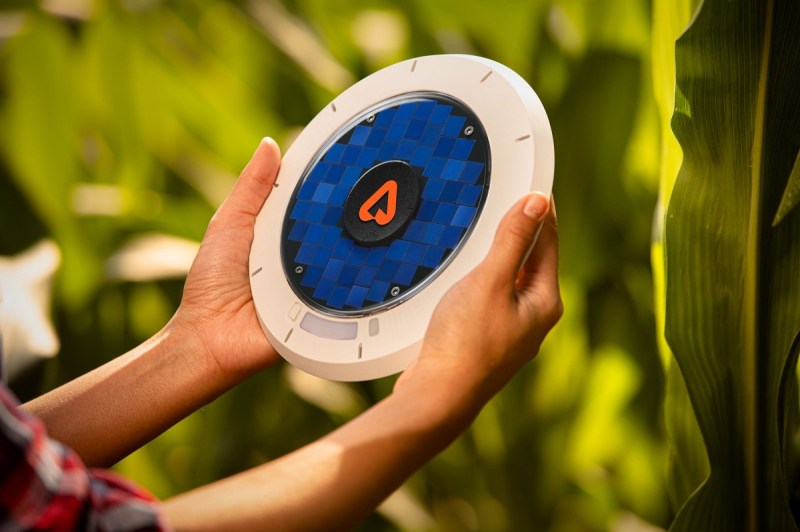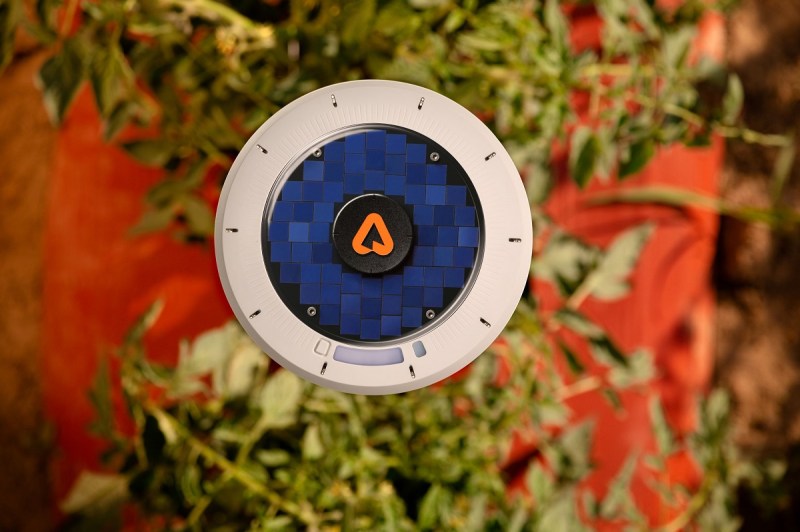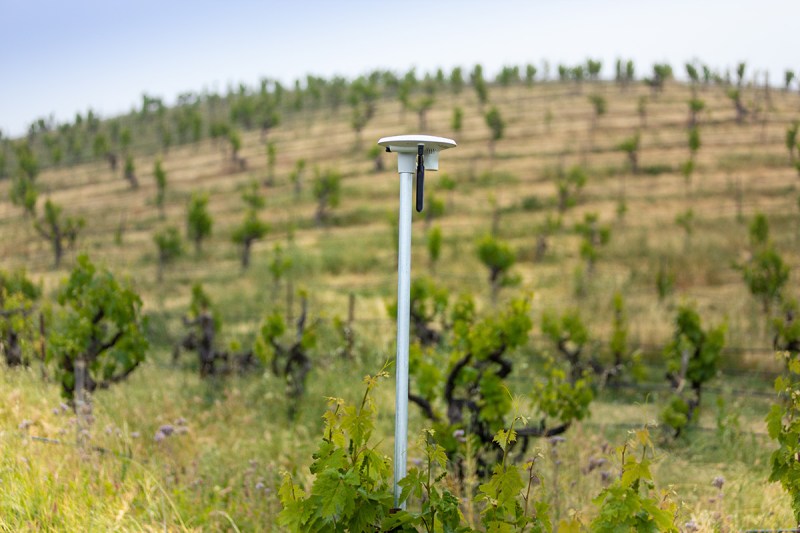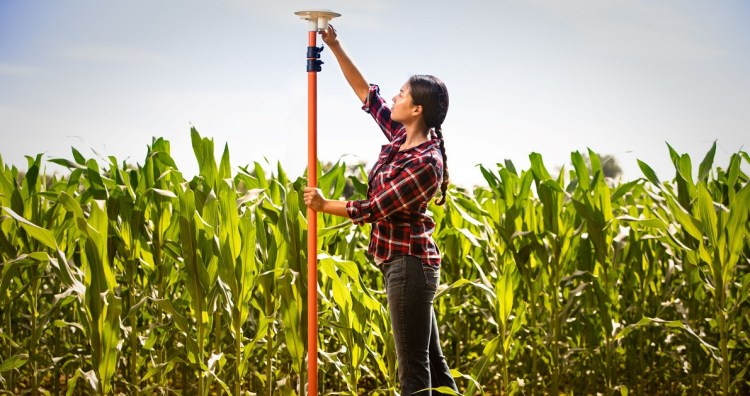Arable is moving agriculture tech forward today with a new generation of internet of things (IoT) tools that enable farmers to take advantage of advanced sensors, wireless networks, and machine learning recommendations to improve crop growth.
The company has come up with a new Mark 2 sensor, a new mobile app, a sensor-integrating bridge device, and Arable Open, a customizable applications programming interface that partners can use.
The solution comes as rising pressures around climate resiliency, mitigation, and adaptation are revealing the urgent need for thoughtful and efficient land use. Arable already has hundreds of partners and customers in the industry across 37 countries.
Agricultural pressures

Above: Arable’s internet of things crop sensor.
In the past decade, about 23% of anthropogenic greenhouse gas emissions have derived from agriculture, forestry, and other land use, putting it just behind electricity and heat production (25%) and ahead of industry (18%).
June 5th: The AI Audit in NYC
Join us next week in NYC to engage with top executive leaders, delving into strategies for auditing AI models to ensure fairness, optimal performance, and ethical compliance across diverse organizations. Secure your attendance for this exclusive invite-only event.
“We’re at this critical stage in agriculture where we’re faced with the pressures of a changing climate,” said Arable CEO Jim Ethington. “And agriculture is one of the most impacted industries. And we hear it all the time from our customers. Farmers say they won’t be able to grow crops in a region in five years. Their yields are down in hot years. And so we’re seeing the pressures of climate change in agriculture. And yet at the same time, there are these new technologies that are becoming available around IoT around the ecosystem of machine learning technologies that can be brought to bear to provide new tools that give farmers the ability to leverage data and improve their operations. And that’s really what Arable is about.”
Poor water availability and elevated ozone levels are projected to cause global vegetable and legume yields to fall by 35% in the next 80 years. Every degree Celsius increase in global temperature correlates to a 5-15% drop in overall crop production. Climate change is pushing Cabernet Sauvignon out of Napa.
The answer to the problem lies in data, according to Arable. Data collected across the agricultural supply chain, digested and distilled with useful analytics, is the most powerful tool for adapting to new conditions and mitigating their harmful effects on economies and people’s well-being.
This is what compelled Arable’s team to build their new suite of agronomic solutions. Building on the success of the original Mark device and Insights platform, Arable sought out feedback, pain points, and ideas from early adopters to understand what was missing, and challenged its engineers and scientists to test the limits of what was technologically possible. The company says the result incorporates deep machine learning, robust data science, and weather model and remotely sensed data to reshape the way we address the most important challenge of our time.
“There are a lot of new technologies out there,” said Dubi Raz, global agronomy director for partner Netafim, in a statement. “But Arable is real.”
Mark 2 sensor

Above: Arable’s sensors can tell if crops are getting enough water.
The Mark 2 is a solar-powered weather station, crop monitor, and irrigation management tool. It features more than 30 enhancements over the original, including improved sensor accuracy, expanded cellular connectivity, extended battery life, and a protective UV coating to withstand extreme temperatures and harsh environments. The device installs in minutes, deploys with the push of a button, and requires no maintenance.
While satellite imagery has long been used in agriculture to monitor fields, there are challenges to using this data for decision-making on the farm: The images aren’t that frequent, and when they are available, their usefulness depends on good light conditions and can be unreliable due to interference from clouds. Arable solves this problem by taking zero-interference measurements directly above the plant canopy, with the same types of sensors deployed on satellites, at five-minute intervals. These measurements are then integrated on the full spatial scale of the satellite to provide reliable recommendations that take into account every corner of a grower’s field and every key event of the growing season.
The Mark 2 weather station starts with a sensor product that goes out in the farmer’s field and senses both the plant and its environment. It can tell from looking down at the crop if it needs fertilizer or water, and it detects the presence of rain, temperature changes, solar radiation, and what is happening in the soil.
“It’s a holistic measurement system that feeds into the back end, where we have a machine-learning recommendation system,” Ethington said. “It turns it into recommendations for the farmer.”
The biggest recommendation revolves around water, which is now a scarce resource in many parts of the world.
“We’re helping the farmer to determine exactly how much water that plant needs each day,” Ethington said. “It also provides elements of things like crop protection, like a fungicide to protect it from disease. And if I do that, when should I do it, and then also fertilizer or nutrients in the soil.”
Ethington said a farm needs approximately one of these sensors for every 20 acres.
“That allows you to manage that field or that block effectively,” he said. “It also makes things like your weather forecast more accurate. Most weather estimates are not very accurate or relevant to a specific field.”
Farmers pay a subscription for the connectivity, the software, and its support.
Arable Bridge gathers data in the right place

Above: The Arable Mark 2 measures weather, crop health, and irrigation needs.
In addition to the intelligence created by Arable’s sensors and system, its platform can connect familiar third-party sensors and make them more useful. One of the biggest challenges in agricultural technology is that there are too many disconnected systems to use. By tying its data to sensors like soil moisture probes and irrigation flow rate sensors, Arable puts all key data about the growing season in one place.
The goal is simplicity in the field, data in context for better decisions, and lower costs. Arable says it does this through Arable Bridge, which offers an intuitive way to collect data from auxiliary sensors and seamlessly integrate it into its platform for useful, real-time analysis.
Arable also offers version 2.0 of its API, which lets platform users contribute, edit, and collaborate on one agricultural software solution. Arable Open was designed for interoperability, meaning the data can be integrated into a wide range of digital farming platforms.
How Arable got started

Above: Arable uses machine learning to recommend crop care.
Arable chief scientist Adam Wolf founded the company in 2016. He worked as an agricultural researcher at Stanford and Princeton and was travelling around the world, studying the dynamics of plants and crops. Wolf realized he had to set up and install incredibly complex, expensive systems to measure all the elements needed and then run experiments that cost hundreds of thousands of dollars. He found he was spending his time setting up and maintaining the network instead of actually doing research.
So he went back to the lab at Princeton and started building one simple device that could do all the work. It took him a couple of years of building and iterating, but that was the genesis of Arable’s core sensor product. The company launched its first commercial products in 2017, and Ethington joined the next year.
“My day started with Arable, and my day ended with Arable. It was the bookend of every day,” said Carolina Hemp’s Chuck Dietzel, an Arable customer and seventh-generation farmer in South Carolina, in a statement.
Now Arable has 30 people in San Francisco and is launching its second generation of tools for agricultural IoT. The company has raised $18 million to date from Middleland Capital, S2G Ventures, Spark Labs, Cantos VC, Village Capital, Thrive Accelerator, and the National Science Foundation.
“We’re taking a totally new approach to solving an age-old problem of how you grow crops efficiently and sustainably,” Ethington said. “What’s cutting edge about what we’re doing is the way that we combined new IoT technology and machine learning to be able to provide recommendations and insights to farmers, but also do that in a super-scalable way. And so we think about consumer ease of use and enterprise-grade reliability. It took innovations in how we build the product, how we connect it, how we power it. And the result is actually a product that is very simple.”
Better networking and weather monitoring

Above: Arable taps new kinds of networking for connecting IoT devices.
New technologies coming along — like 5G networking and narrowband IoT — should help.
“What those allow us to do is to connect our device to the existing cellular network and cell towers, but to do that 6 times farther than you would be able to do with your cell phone,” Ethington said. “It’s also doing that at 4 times less power usage in the device than you would get with a standard cellular modem. And so that opens up broad connectivity for farming in rural areas.”
Arable also has a better approach to measuring rainfall than looking in a bucket. It has solid-state sensors with no moving parts and simple maintenance requirements. When rain hits the device, it produces an audio signal that microphones listen for so they can record how much rain has fallen in a given time.
Arable is working with partners to integrate its tech so it works with a variety of equipment, such as irrigation electronics. In that realm, Arable is working with BASF, Netafim, Treasury Wine Estates, Ferrero, and Mars.


